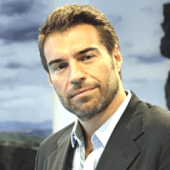Navigating the future of work through trust and empowerment with Protiviti’s EVP of Global HR
IN BRIEF
- Leaders everywhere should embrace the changes we are living through as an opportunity.
- Demonstrate trust through showing transparency, demonstrating fairness, leading with empathy and investing in the future.
- If you want your team to trust your decisions, buy into what’s possible and meet the organization's priorities, here’s an idea: You go first.
Back in January 2020, Protiviti had 65 global leaders come together, as we do at the beginning of each year, to outline the firm’s business plans, strategy and individual commitments for the year ahead. For this meeting, we brought in a team of consultants with expertise in human-centered design to work with us and help us answer the following question: How might we attract and retain the most admired consulting workforce on the planet?
We were studying that question, in part, because we had a persistent issue around our people's need for greater flexibility in their work lives—not just where they were working but with whom, when and how. In those days, it was called “work-life balance.” Our people wanted more of a voice and more of a choice in the decisions related to their work.
At the meeting, we broke our leaders into small groups to begin brainstorming. Soon enough, the walls and dry erase boards were filled with great ideas about how we might better attract and retain great people. In a debrief to the full group at the end of the session, one leader shared what could be, perhaps, a life-changing suggestion: “What people want is 100% flexibility!” Well, we all looked around the room thinking, "Wouldn't that be wild?" Like the animals in charge of the zoo. Well, I think you know how this one ends.
The real world has proved just how much flexibility employees can actually manage while delivering amazing results. And as businesses now look ahead and plan how their organizations and their people will work together in a hybrid work model, employees’ desire for flexibility has, naturally, never been greater. I am convinced, now two-plus years into a global pandemic, of this:
- Leaders everywhere should embrace the changes we are living through as an opportunity.
- Hybrid work enables us to engage more fully with our people. It’s a win-win.
- Trust and empowerment are the currency in this relationship.
Empowerment and “Discretionary Effort”
Empowerment is a leadership action, which we define as the igniting of the discretionary efforts of your team members to do the right things. “Discretionary effort” is an important phrase in that statement. It means going further than you have to, going the extra mile, giving more than is expected. Why would team members go further than they have to? Because somebody lit a fire under them, somebody sparked them to do so—most likely through open communication, by casting a vision, or sometimes just by being genuine and open about what's going on. Seeing this, the team member is inspired to take action. They want to help. You’re igniting discretionary effort in them, and people who go further than expected are the difference makers on your team and in your organization. Only the employee can give you more than you're expecting. They make that choice.
Empowerment is a leadership action, which we define as the igniting of the discretionary efforts of your team members to do the right things.
Our Trust-Building Agenda
At Protiviti, through surveys of our people, we’ve been using data gathered over the past few years to identify some critical elements to help us build the kind of trust that empowers our people. We identified these elements prior to COVID, but the pandemic proved them out. And as we look ahead to the future of work and the hybrid workforce that it activates, we are anchoring to these four points in our trust-building agenda.
1. Greater levels of transparency
Open, honest, direct and frequent communication, clarifying the decisions that we have made and why we made those decisions. Sometimes it's as simple as leaders telling personal stories. Why am I here? How did I get here? Or maybe sharing their own personal views. How has this affected me? What have I learned through this? Other times, leaders shine a light on things people want to know more about. How does compensation work? How do people get promoted here? What is going on in our business? All of those things, when discussed and disclosed transparently, generate higher levels of trust.
2. Address issues of fairness
Once people can see inside, they naturally start making assessments. Based on what I can see (transparency), is this fair? Is it good for me? Is it equitable? Younger workers, we’ve discovered, increasingly want to be assured that it's fair for everybody. Fairness and equitable for everyone are guiding principles for them. If that's how promotion decisions are determined, is that what it looks like when I view the actual promotions made? If that's how compensation works, is that how it works for me, and is that what I hear about how it works for others? So, this “for all” element to fairness is a real driver in generating higher levels of trust. Not only can I see what's there, but I also think that it's fair.
3. Leading with empathy
Listening to people builds trust. Empathy is valuing the point of view of another person. The way you value that point of view is not just by asking for feedback but also by listening, communicating back what you’ve heard and then acting on it. First, we actively seek to understand another person's point of view, and then we act on what we learn. That is the secret to leading with empathy—using your position of influence to achieve an outcome that they will value. You must know what it is they are saying, and you have to be prepared to act on it. As a result, they feel like they are shaping the organization’s agenda, and they are!
4. Investing in your people for the future
Nothing says trust like, “We're willing to invest in your future when we don't really know how long you're going to be here. We're going to contribute to your individual growth and development because we value you and your contributions.” In a transparent organization, people know where the growth will come from and will often want to align their capabilities and skills so they can best contribute to that growth. This creates real opportunities. Help them get there with training, development and the work experiences they need.
We have found that these four elements build trust in the organization, and they are based on feedback from what our people consistently reveal in our surveys.
Here’s one more thing to consider: Trust is a two-way street in any organization. Not only are you looking for your people to trust the organization and the leaders in that organization, but wouldn't it be great if the leaders also had higher levels of trust in the employees? Are your employees being transparent? What do they want to do? Are they telling you what's going on? Do they love what they’re working on? Will they tell you they are considering leaving? Will they point out a problem while it is still easy to handle? Can you see what's important to your people? Are they being fair? Are they willing to listen to the viewpoints of others and take actions based on what they're learning? And are they willing to invest in an organization even when they don't know every step on their career journey going forward? If they are, that would inspire higher levels of trust among your leaders.
Nothing says trust like, "We're willing to invest in your future when we don't really know how long you're going to be here."
Conclusion
As we consider this unprecedented opportunity presented by hybrid work, the foundational elements are empowerment and trust. How will hybrid work take us, our people, and our clients to an even higher plateau? How will hybrid models work when employees are making more of the decisions about the work? Will they go the extra mile? Will they do the right things? How do leaders empower the team to take the initiative and go further than expected in doing the right things? Trust.
Right now, we are on one side of a great chasm—like the French Verdon Gorge, the Brazilian Itaimbezinho Canyon or the Grand Canyon in the U.S.—and need to navigate to the other side, over to where the Future of Work is. It potentially could be a treacherous journey, but leaders need to find their footing. We need to energize our people even as there continues to be so much change swirling around us—government health mandates, a tight labor market, a blocked supply chain, escalating salaries, high levels of turnover. We know more change is coming, and the pace of change is accelerating. Do we have what it takes to get to the other side? Can we trust our people to take us there?
We often want our people to earn our trust before we extend it. We will give them empowerment when we are sure they know how to use it. If you want your team to trust your decisions, buy into what is possible and meet the organization's priorities, here’s an idea: You go first. Take that first step and extend trust. Now, that first step might cause the bridge across the chasm to start swaying and undulating, thus creating some discomfort, but no doubt you will find your rhythm, feel the groove and pick up momentum. Step out first and be ready to demonstrate trust through showing transparency, demonstrating fairness, leading with empathy and investing in the future. Trust your people and empower them to succeed. You may be surprised at the benefits you reap together.
Trust your people and empower them to succeed. You may be surprised at the benefits you reap together.





























